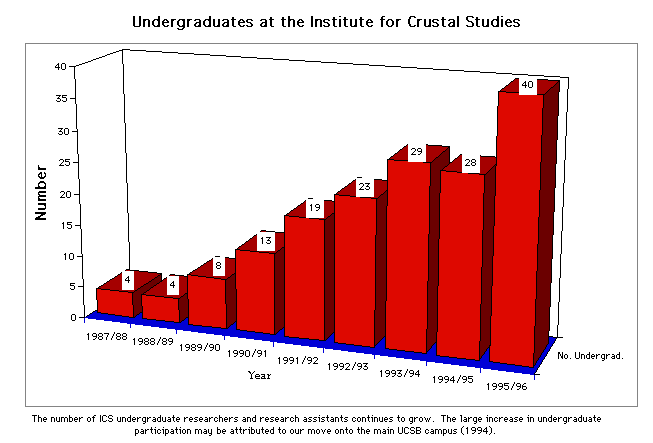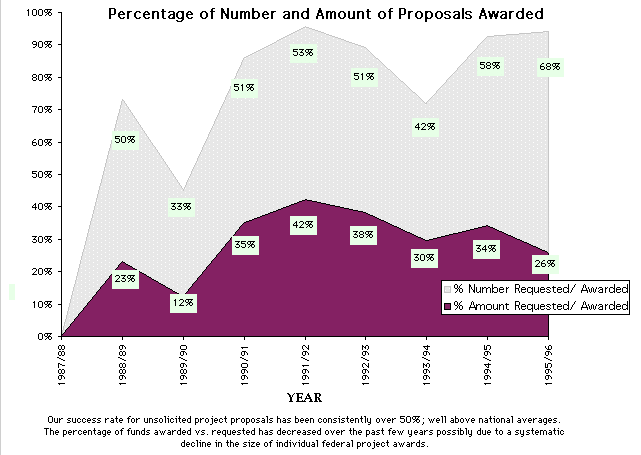The goals of the ICS include achieving an increased understanding of the crust
and lithosphere of the earth by utilizing the approaches of many disciplines
and the expertise of scientists in academia, government, and industry.
The current mission of the ICS is to provide the research leadership,
organizational structure and facilities to promote the cooperation of
scientists from various research groups and organizations on problems
concerning the earth's crust. At present the research agenda of the ICS
comprises the study of crustal structure and tectonics,
crustal materials, earthquakes, and hazardous
waste disposal.
Section V below outlines some of our more notable projects during this past
year. These include: a finding of very high expected ground shaking in the Los
Angeles basin as a result of modeling a hypothetical earthquake on the San
Andreas fault; discovery that hydrocarbons leaking into the subsurface are
rapidly consumed by bacteria and constitute a lower pollution risk than
currently expected; participation of undergraduates on an Antarctic research
expedition; and discovery of a possible inverse correlation between the rate of
natural hydrocarbon seepage offshore Goleta and offshore oil production.
ICS continues to involve nearly a dozen graduate students in thesis research
projects that range the full gamut of our research agenda from earthquakes to
hazardous waste. Graduate students are studying active faulting in the Santa
Barbara area and seismic hazards for our own campus. Others are studying
tectonics in the remote Brooks Range of Alaska. Students present their results
at national meetings supported by ICS research grants. Last year graduate
students Fabian Bonilla, Julie Bryce and David Oglesby presented papers at the
Fall national meeting of the American Geophysical Union, Robert West presented
at the national Fall meeting of the Geological Society of America, and David
Oglesby also presented a paper at the Spring meeting of the Seismological
Society of America.
ICS has seen a large increase in the numbers of undergraduate students
involved in our research program (Fig. 1), totaling 40 last year. In most
cases these students are largely working independently and are not just
assistants. Many are involved in independent research including the UCSB FRAP
program, and the NSF Research Experience for
Undergraduates program. For Summer 1995, we had four undergrads
selected to be interns at ICS for the Southern California Earthquake Center.
They did independent research on topics including ground motion expected from
earthquakes to mapping fault lines in the Santa Barbara Channel. Four
undergraduates are participating in the UC Campus-Laboratory Collaboration
project (Section VIII) to determine the seismic hazard on our campus. Seven
undergraduates participated in a research expedition to Antarctica this past
winter.
ICS activities respond to public interest in several ways including specific
research projects (Section V) and public outreach (Section VI.1). Our research
agenda and activities in earthquakes and environmental quality are of vital
public interest.
ICS has an active outreach public program on earthquakes, described later on.
We are frequently interviewed by the media to comment on earthquake events and
issues. Our study of ground motion in the Los Angeles area was covered by
national television. We installed real-time earthquake map video monitors in
local high schools and on campus. We are in the process of studying seismic
hazards for the UCSB campus.
Offshore from UCSB are some of the largest submarine hydrocarbon seeps in the
world. This natural seepage is responsible for local beach tar and air
pollution. ICS is studying these seeps to quantify their impact and to describe
their behavior.
Leaking buried gasoline tanks have been identified in the past as a
significant threat to ground water in California. In an ICS project, our
researchers determined that consumption of hydrocarbons by bacteria in soils
reduce this contamination in almost all case; an unexpected result.
ICS has on its roles 13 faculty and 20 Professional Researchers as Principal
or Co-Principal Investigators. The number of PIs has seen steady growth,
doubling since 1990/91, mostly by the addition of Professionals. This past
year we had five long-term visitors including one from industry, one from Yale,
and three from French universities. Over the years our members have
distinguished themselves by securing grants and national and international
honors. During last year Dr. Lorne Everett received an honorary doctorate from
Lakehead University in Ontario.
Our student roles have grown steadily, particularly the number of
undergraduates involved in our research which has increased to 40 last year,
doubling since 1991/92 (Fig. 1). Our undergraduates have secured their own
honors. Kirsten Zellmer was named as outstanding senior in the Geological
Sciences Department. Windy Brimer, Andy Byers, Jason McKenna and Mike Watkins
were selected as 1995 Summer Interns for the SCEC. Undergraduate Erik Vanek
received an award from The Society of Technical Communication for his paper on
remote sensing of sea ice surrounding Antarctica.
This past year ICS managed 38 projects worth well over $6 million. Our growth
in both these categories continues at a steady rate (Fig. 2). We submitted 58
proposals last year requesting almost $7 million. Our success rate is well
above national averages. Well over half our requests were awarded last year,
and this has been fairly consistent over our history (Fig. 3). However, we
have noticed a down trend in the percentage of funds received; last year we
received 26% of our requested funding, down from a high of 42% in 1991/92 (Fig.
3). This could be interpreted as less generous funding of awards by agencies,
reflecting increasingly austere federal budgets.








